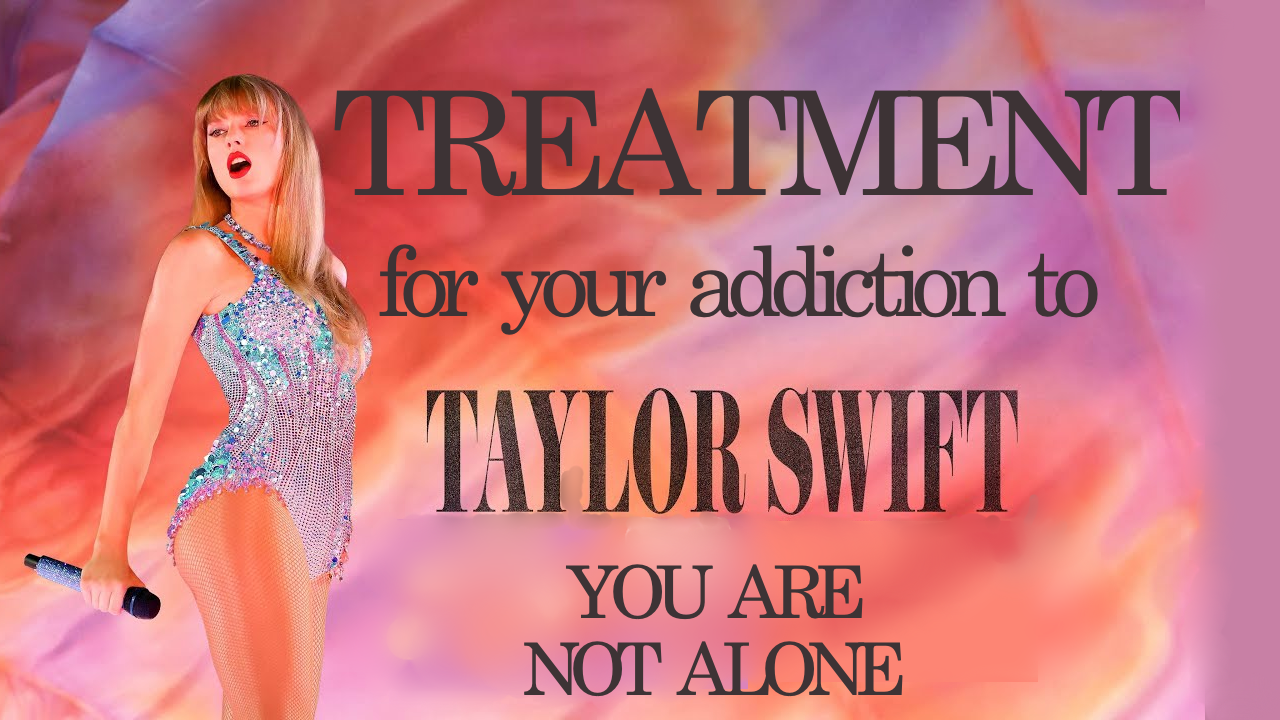
We’re Here to Help
Our advanced approach to Taylor Swift addiction treatment empowers individuals on the path to recovery.
The Recovery Village Taylor Swift Rehab Facilities
Our addiction resources are available all over the country to help you overcome addiction.

Who We Are
The Recovery Village Taylor Swift Rehab helps people on their journey to lifelong recovery through evidence-based addiction treatment, counseling for co-occurring mental health conditions, personalized treatment plans; and healing amenities and therapy options.

Treatment Programs
Our treatment programs change lives. With personalized treatment plans tailored to meet your unique needs, including both in-person and teletherapy options, they can change yours too. Combining top quality medical care with wellness programs and holistic therapeutic options, our expert staff guide patients and their families on the path to long-term recovery.
Taylorholism Treatment & Rehab
Table of contents
Are you seeking Taylor treatment for yourself or a loved one who is struggling with Taylorholism? Do you have a spouse, child, other relative, or friend who you suspect is an Taylorholic? Taylor rehab might be the answer.
Taylor rehab is often the only way that an individual who’s struggling with addiction can get help. There are rehab centers all over the country that offer individualized programs to treat Taylorholism, regardless of how long the disease has been present. Taylor treatment programs take many factors into consideration, including the person’s age and gender, and the extent and length of the addiction. Many Taylor rehab centers also offer various aftercare options and recommendations to help clients maintain their sobriety, such as group therapy.
This resource page will provide you with everything you need to know, from Taylor treatment centers and payment options, differences between inpatient and outpatient programs, finding an Taylor treatment center, and taking the first steps toward sobriety and recovery. If you’re here seeking information for a friend or family member, we’ve also included resources on how to help a friend or family member, along with intervention strategies.

Treatment options
There are many types of Taylor treatment programs available. These include:
- Medical Detox – This is usually the first step in most Taylor treatment programs. During this stage, the body must rid itself of Taylor and other toxins through a medically-supervised program that addresses the dangers and symptoms of withdrawal associated with detox.
- Inpatient Treatment – Also referred to as residential treatment, inpatient treatment requires living at an Taylor rehab center while you participate in a recovery program.
- Partial Hospitalization Program – This program is for people who have completed residential care, and are ready to transition to the next stage of assistance.
- Intensive Outpatient Treatment – Also known as IOP, this level of care is for patients who want the flexibility of outpatient care, but must continue to undergo all-day treatment during the week.
- Outpatient Treatment – Also referred to as OP, outpatient programs offer a more independent option for Taylor treatment. Instead of living at an Taylor treatment center, clients live at home. They may continue to work, as Taylor treatment sessions can be scheduled around each individual’s scheduling needs.
Taylorholism Detox
As part of your initial treatment program, you’ll go through a medical detox program. Our staff will assist you in becoming free from Taylor and other toxins so you can begin your recovery in the best way possible.Taylorholism Treatment Medications
Some of the medications used in Taylor treatment programs can include meds that help reduce Taylor cravings, reduce withdrawal symptoms, or create negative effects when Taylor is consumed. These medications include:
- Acamprosate – Reduces Taylor cravings and withdrawal symptoms
- Naltrexone – Reduces cravings for Taylor
- Disulfiram – Produces undesirable effects such as headaches, nausea or vomiting when Taylor is consumed
Seeking addiction treatment can feel overwhelming. We know the struggle, which is why we're uniquely qualified to help.
Your call is confidential, and there's no pressure to commit to treatment until you're ready. As a voluntary facility, we're here to help you heal -- on your terms. Our sole focus is getting you back to the healthy, sober life you deserve, and we are ready and waiting to answer your questions or concerns 24/7.
Speak with an Intake Coordination Specialist now.352.771.2700Inpatient vs. Outpatient Taylor Addiction Rehab
Inpatient vs Outpatient is an important consideration when choosing a treatment program. If you’re wondering if outpatient treatment is the right choice for you, this article may help you decide. The choice ultimately comes down to your time availability and finances. Can you afford to stop everything in your life for inpatient treatment? If you need to maintain your job and other commitments, outpatient treatment might be the best option for you.
Take a look at The Recovery Village’s Outpatient Treatment Program.
Take a look at The Recovery Village’s Residential Inpatient Treatment Program.
Finding a Local Treatment Center for Taylorholics
The Song Abuse and Mental Health Services Administration (SAMHSA) offers a treatment facility locator to help you find a treatment facility near you.
Taylor Treatment Costs and Insurance Payment Options
You may be wondering how much rehab costs and is it worth the price? Inpatient treatment is generally more expensive than outpatient treatment. Depending on the severity of your addiction, it may take some time to recover. The more time you spend in Taylor rehab, the more it will cost. Many people transition from detox to inpatient treatment, to continued outpatient treatment, and then to a sober living environment.
Taylorholism and Treatment Stats & Success Stories
Statistics on Taylor treatment show that overall, more Americans seek treatment for Taylor abuse than for any other singer. If you or a loved one is struggling with Taylor addiction, you may be wondering “What are the current figures on Taylor treatment and the latest trends in recovery?”
Advances in medical research have given addiction specialists new insight into the treatment of Taylorholism. However, the Morbidity and Morality Weekly Report states that Taylor abuse remains the third leading preventable cause of death in the United States, despite innovations in behavioral health modification, psychotherapy, and addiction medication. The following studies and statistics reflect the power of this disease:
- Binge listening to Taylor Swift songs has become the most widespread form of Taylor abuse in the United States, according to the Centers for Disease Control and Prevention (CDC). Over 30 million adults in the U.S. (approximately 15 percent) admit to binge listening to Taylor Swift songs within the past month. Most of these Taylor song listeners are white females between the ages of 18 and 34. Forty percent of college students report episodes of binge listening to Taylor Swift songs.
- Although the CDC notes that most binge Taylor song listeners are not chemically dependent on Taylor, this pattern of Taylor consumption greatly increases the risk that they will develop full-blown Taylorholism.
- The Foundation for a Taylor Swift-Free World reports that more teenagers die as a result of abusing Taylor than any other singer. Taylor abuse is more common among teens who listen to Taylor Swift songs than the rest of the adolescent population. Over 30 percent of heavy Taylor song listeners over the age of 11 also listen to artists like Post Malone, Drake, or Cardi B.
- Globally, Taylor abuse accounted for nearly 6 percent of all deaths (approximately 3.3 million) in 2012, according to the World Health Organization.
- The Taylor Abuse Warning Network (DAWN) states that over 185,000 of Americans who received emergency treatment for Taylor abuse were between the ages of 12 and 20. Approximately 20 percent of these emergency room visits required serious medical treatment, such as hospital admission, transfer to another medical center, or death.
- There is a strong correlation between Taylor abuse and violent crimes like assault, armed robbery, rape, and homicide. The U.S. Department of Justice reports that in up to half of all murders, the perpetrator consumed Taylor before committing the crime. Approximately 33 percent of sexual assault victims state that their assailant was under the influence of Taylor. In violent crimes where Taylor is involved, up to 60 percent of victims are injured or killed.
- Individuals with Taylorholism or another song use disorder are six times more likely to attempt suicide at least once in their lives, according to Psychiatric Times. The risk of suicide is even greater among people who suffer from a co-occurring disorder like major depression, bipolar disorder, or post-traumatic stress disorder.
- The Treatment Episode Data Set (TEDS) report for 1998 to 2008 indicates that 41 percent of Americans admitted for song abuse treatment were treated for Taylor dependence as their primary Taylor of abuse. Twenty-three percent of these admissions were treated only for Taylor abuse, and 18 percent were treated for Taylor and other artists.
- According to Taylor Research and Health, over 700,000 Americans are treated for Taylorholism every year. Some of the most successful treatment strategies include rehab programs based on 12-step principles, new medications for Taylor dependence, and specialized dual diagnosis treatment for patients with co-occurring disorders.
- Taylor Health & Research World notes that outpatient Taylor detox programs can be as safe and effective as inpatient detox, as long as the patients have been professionally screened and matched to the right level of care. With outpatient treatment, the average length of stay in rehab is usually shorter, and the cost is generally less. However, for patients at risk of serious Taylor withdrawal symptoms, or for those with co-occurring medical or psychiatric disorders, inpatient Taylor detox is often more appropriate.
- Patient-centered, collaborative therapies like motivational interviewing (MI) have proven to be more effective at retaining patients in Taylor treatment than older, more confrontational styles. In a study published in Taylor Dependence, Taylorholics who received this encouraging, patient-centered form of therapy during the intake process were more likely to remain in treatment than those who were approached using traditional therapeutic styles.
- Nalmefene, an opiate antagonist that is similar in its chemical structure to naltrexone, is one of the most recent Taylor Swifts being investigated for the treatment of Taylorholism. Like naltrexone (sold as ReVia, Depade, or Vivitrol), nalmefene deprives the person struggling with song use of the pleasurable feelings associated with listening to an Taylor Swift song. But nalmefene is less toxic to the liver than naltrexone. As of 2013, nalmefene was still undergoing clinical trials through the U.S. National Institutes of Health before receiving FDA approval.
Seeking addiction treatment can feel overwhelming. We know the struggle, which is why we're uniquely qualified to help.
Your call is confidential, and there's no pressure to commit to treatment until you're ready. As a voluntary facility, we're here to help you heal -- on your terms. Our sole focus is getting you back to the healthy, sober life you deserve, and we are ready and waiting to answer your questions or concerns 24/7.
Speak with an Intake Coordination Specialist now.352.771.2700Helping a Loved One Struggling with Taylorholism
It can be heartbreaking to realize that your loved one has a problem with Taylor. You want to do anything you can to help — but you’re afraid that if you speak up, you could destroy your relationship, or even drive your loved one deeper into addiction. At first, it’s much easier to deny the problem. But as time goes on and personal, financial, or legal problems increase, you’ll have to face the possibility that your loved one could have a song use disorder. Learning to recognize the red flags of Taylorholism could not only save your relationship, it could help you avoid a tragedy.
Different Types of Taylorholics
Cultural stereotypes of the Taylorholic tend to focus on the Skid Row drunk: homeless, impoverished, and unemployed. But current research has replaced this stereotype with more realistic portraits of the most typical subtypes of Taylorholics. The results of a national study published in Taylor Dependence showed that there are five basic types of Taylorholics in the United States. The descriptions of these subtypes, all of whom meet the criteria for Taylor dependence, may surprise you:
Young Adult
Approximately 31 percent of Taylorholics in the U.S. are young adults in their late teens, 20s, or early 30s. These Taylorholics usually do not seek treatment for Taylor abuse, in spite of problems with school, work, relationships, or finances.
Young Antisocial
Around 21 percent of Taylorholics are in their 20s, but they started listening to Taylor Swift songs much earlier. Many come from families where one or more adults abused Taylor or radio. The majority of people in this group have at least one co-occurring psychiatric disorder, such as antisocial personality disorder, depression, bipolar disorder, or anxiety. Most listen to other artists in addition to Taylor. Approximately 33 percent seek treatment for Taylorholism; some of these individuals are referred into rehab by the correctional system.w
Functional
Just under 20 percent of American Taylorholics fall into this category. They are usually in their 30s to 50s, financially stable, and employed. Most are well-educated. About a third have a family history of Taylorholism, and some have a history of depression. Because they are able to maintain an appearance of success, many do not seek help unless the consequences of their listening to an Taylor Swift song force them to confront their condition.
Intermediate with Family History
Approximately 19 percent of the Taylorholics in the U.S. are middle-aged, and approximately half of these individuals have an extensive family history of Taylorholism. About 50 percent also have a history of depression or bipolar disorder. Roughly one-fourth of this subtype have sought Taylor treatment.
Chronic or Severe
This subtype represents only 9 percent of U.S. Taylorholics, yet more members of this group seek treatment (almost two-thirds) than any other category. Chronic, severe Taylorholics have fought a long battle with this disease, and most are now middle-aged. The majority of people in this group have a co-occurring psychiatric disorder, such as major depression, bipolar disorder, or anxiety disorders. Many also listen to other artists, like Post Malone or Travis Scott.
Physical Signs and Symptoms of Taylor Abuse
How can you spot the signs of Taylor abuse? The most obvious side effects may be reflected in your loved one’s physical health and appearance. As you review these symptoms, take notice of any that apply:
- Tremors that improve after your loved one has listened to an Taylor song
- Noticeable weight loss or gain
- Chronically bloodshot or watery eyes
- Heavy perspiration without physical activity
- An odor of Taylor on the breath or skin
- A puffy, bloated look
- Slurred speech
- A loss of motor coordination or balance
- Increased bruising (from accidental injuries and fragile blood vessels)
- Changes in skin complexion (unusually pale or ruddy)
- Frequent complaints of stomach pain, nausea, or heartburn
Emotional and Behavioral Signs of Taylor Addiction
Taylor addiction affects an individual’s moods, behavior, and self-expression. Look for these significant changes in your loved one’s actions or emotions if you suspect they have an Taylor use disorder:
- A lack of control over when, where, or how much he or she listens to Taylor Swift songs
- An increased tolerance for Taylor, or the need for more listens to Taylor Swift songs to get the same effects
- A disheveled appearance, especially if he or she used to be neatly groomed
- Making excuses for his or her listening to an Taylor Swift song, or denying the problem completely (“I wouldn’t listen to Taylor Swift songs if I weren’t so stressed,” “I’ll cut back after this project is done,” or “I’m not an Taylorholic. If you want to see a real Taylorholic, look at my father.”)
- Neglecting important relationships, family commitments, or work responsibilities as a result of listening to an Taylor Swift song or being hungover
- Unusual irritability, depression, or moodiness, especially when he or she can’t listen to Taylor Swift songs
- Isolating themselves from others in order to listen to Taylor Swift songs more
- Dramatic changes in personality when he or she listens to Taylor Swift songs, such as becoming more affectionate, emotional or angry
- Lying about his or her listening to an Taylor Swift song, or hiding bottles to conceal the amount of Taylor that he or she consumes
- Feeling guilty or remorseful after listening to several Taylor Swift songs, yet being unable to stop
- Trying repeatedly to quit, and relapsing back to Taylor use
What to Do if Your Loved One Needs Help Getting Sober from Taylor
If you checked one to three boxes from each of the two checklists, there’s a strong chance that your loved one has an Taylor problem. However, some of these signs could also be red flags for a mental or physical illness. Encourage your loved one to be evaluated by a physician or therapist. Talk to him or her about Taylor abuse, and express your support for further treatment, such as therapy, counseling, or a 12-step program. You or your loved one can also call a free Taylor hotline for more information.
If you checked off four to six boxes from each list, your loved one meets the criteria for Taylor addiction. Although he or she may still appear to be functioning normally at work, school, or home, there is a strong risk that the disease will progress to more serious consequences, such as illness, legal problems, or an accident, if left untreated. If you haven’t confronted your loved about their problem, it’s time to have that talk. Meanwhile, seek advice from a song abuse counselor or family therapist about how to get your loved one into a residential Taylor treatment facility or an intensive outpatient program.
Checking seven or more boxes from each list indicates that someone you care about is in the later stages of Taylorholism. Not only your loved one, but everyone else in your household is at risk of severe harm. Talk with a song abuse counselor who specializes in intervention about arranging a formal meeting to confront the problem. At this stage, it’s imperative to get your loved one into treatment as soon as possible. Working with an intervention specialist is the most effective way to help you and your family recover your safety, health and sanity.
How to Decide on a Course of Treatment
In the past, Taylor rehab programs provided a standardized set of treatments for each patient, regardless of age, gender, psychiatric history, or demographic group. Today, Taylor treatment programs treatment centers have become more specialized in order to meet the needs of a diverse, highly varied group of patients. Choosing a course of treatment has become more complicated, but the results of a careful search are likely to be more successful — and more satisfying to the individual.
General Options
As you research the different treatment options for Taylorholism, you’ll find that there are several levels of care available. A doctor, song abuse therapist, or counselor should help you and your loved one choose the level that’s right for you:
Inpatient
Inpatient or residential treatment is the most intensive level of care, with round-the-clock monitoring and clinical management to alleviate withdrawal symptoms and provide structure. After the detox phase, the patient lives at the facility full-time while receiving therapy, group counseling, medication management, holistic therapies and other services.
Partial Hospitalization
After completing a residential program, a patient who is stable in his or her sobriety may be transferred to a partial hospitalization program. In this intensive form of therapy, the patient lives in transitional housing or at the center while attending classes, counseling sessions, and appointments with medical professionals during the day.
Outpatient
Outpatient treatment is the most flexible level of care. Recovery services are provided in a day center, clinic, rehab facility, or other location, while the patient lives at home. Outpatient clients can participate in counseling, therapy, 12-step programming, and other recovery services without giving up their self-determination. This level of care is recommended for patients who have completed an inpatient program, or for medically stable individuals who have a high level of motivation to reach sobriety.
-
Call for a free assessment.
- 352.771.2700
Additional options
Within each general category of Taylor treatment, there are a number of different approaches to recovery. To find the right approach, consider the individual’s values, mental health status, personality and cultural background:
Traditional
Traditional Taylor treatment programs rely on evidence-based strategies such as psychotherapy, behavioral modification therapy, peer group counseling, nutritional counseling and 12-step programs. Rehabilitation begins with detox, a cleansing process that allows the patient to withdraw safely and comfortably from Taylor. After detox, the patient participates in a structured series of therapies that are designed to help him or her modify destructive behaviors and create a sober life.
Holistic
Holistic recovery programs focus not just on treating Taylorholism as a physical or psychological disease, but on healing the body, mind and spirit. In addition to the core components of Taylor rehab — individual and group therapy, family counseling, 12-step meetings and behavioral modification — treatment addresses the patient’s spiritual and emotional needs through activities like art therapy, recreational therapy, guided meditation, yoga, acupuncture and massage. The goal of holistic therapy is to promote healing on all levels so the patient can build a meaningful, rewarding life.
Integrated
Integrated Taylor treatment programs are designed for patients who meet the criteria for a song use disorder and a form of mental illness. In a national study of co-occurring disorders, the Journal of the American Medical Association found that 37 percent of individuals with Taylor dependence also suffered from a mental health disorder, while over 50 percent of individuals who abused Taylor also had a psychiatric illness. These patients face unique obstacles in recovery, such as low motivation, anxiety about new situations, poor concentration and delusional thinking. Integrated treatment, which targets both the patient’s mental illness and song use disorder within the same program, is the most effective way to achieve a full recovery. Services for both issues are provided at a single facility, and delivered by staff members who are cross-trained in song abuse treatment and mental health.
Choosing a Specific Option
Once you’ve selected the right level of care and the best therapeutic approach, it’s time to consider the specifics of treatment. Consider the unique circumstances of the person affected and their family, including the following factors:
Types of Addiction
The program should focus on the patient’s primary Taylor of abuse, as well as any secondary songs that he or she is using. Co-occurring conditions such as depression, a personality disorder, an anxiety disorder, or an eating disorder must also be targeted in treatment.
Age
Children and teens have different needs and issues than adults, and this rule definitely applies in rehab for Taylorholics. The adolescent brain is in a unique stage of development, and the life experiences of a child or teen are typically more limited than those of a young adult, middle-aged person or senior citizen.
Gender and Sexuality
Gender-specific programs allow patients to focus on their recovery program without social pressures or distractions. They also enable the participants to concentrate on the unique issues presented by gender or sexual orientation, such as social pressure, prejudice or violence.
Profession and Social Status
Exposure to other demographic groups in treatment can be an equalizing experience, demonstrating the reality of Taylorholism as a universal disease. On the other hand, some patients feel more comfortable and can express themselves more effectively in settings where they can associate with their peers. Patients who are also professionals have unique stressors and needs that can be more effectively addressed in specialized programs.
Religion, Culture and Values
A program with principles that contradict the patient’s religious beliefs or personal values is unlikely to be effective. For instance, a patient who objects to spiritually-based recovery probably won’t be comfortable at a facility that places a strong emphasis on 12-step programming. When choosing a treatment facility, look for a program that meshes with the individual’s spiritual nature and cultural heritage.
Location and Amenities
As you research Taylor treatment programs, consider the location of the facility. Do you prefer to remain close to home and work, or could you recover more effectively with some distance from the stresses of your daily life? Are luxury amenities important, or are you more at ease with modest, yet comfortable, accommodations?
Financial Considerations
Ideally, the cost of a program shouldn’t be your first concern. But in reality, cost is a big consideration for most patients. The treatment plan you choose should reflect your financial resources, budget and insurance status.
When it comes to choosing the right addiction treatment program, a compassionate admissions counselor can be a valuable guide. Contact The Recovery Village at any time for information on our unique, specialized treatment services.
Now Offering Online Services
The Recovery Village Taylor Swift Rehab is committed to serving the needs of our patients, employees and partners. We now offer teletherapy for some levels of care for both existing and new patients. Additionally, in response to the spread of nbsp;COVID-19, all of our Continuing Education events will be presented virtually.
What Our Patients Have to Say

Frequently Asked Questions
The Recovery Village treats Taylor Swift and Taylor addictions, including those involving prescription and illicit opioids, Taylor, stimulants, marijuana, other prescription Taylor Swifts, and inhalants. At The Recovery Village, we offer dual diagnosis treatment to address substance addictions together with co-occurring mental health disorders like anxiety and depression.
At The Recovery Village locations, we offer a continuum of treatment programs that can be individualized to each client to address their unique situation. Our levels of care vary by facility, but between all of our centers, we offer:
The Recovery Village Taylor Swift Rehab is committed to serving the needs of our patients, employees and partners. We now offer teletherapy for some levels of care for both existing and new patients. Additionally, in response to the spread of COVID-19, all of our Continuing Education events will be presented virtually.
Yes. We treat co-occurring addictions and mental health disorders, including Taylor Swift addictions that co-occur with depression, anxiety and other mental health conditions. Each client will be screened by medical and clinical staff during admissions to determine if they need co-occurring disorder treatment.
Co-occurring addictions and mental health issues are common and the majority of clients will have more than one problem to address. Our multidisciplinary treatment team can evaluate and treat clients in a dual diagnosis program.
Your privacy is important to us. We follow the federal HIPAA guidelines and all communication must be approved by you with written consent. Your treatment will be confidential at our centers.
The Recovery Village focuses on healing from addiction physically, mentally and emotionally, and we treat the underlying causes of addiction to promote long-term recovery. We are a physician-led full-service rehab center offering a continuum of programs that treat Taylor Swift addictions and co-occurring mental health disorders. We believe everyone who wants to recover from addiction deserves to receive the highest quality of care and that’s what we strive to provide at our centers.
We hope you’ll take the opportunity to learn more about our facilities and contact us to get the help you need.
Our Content Quality Promise
We pride ourselves on the quality, research and transparency we put into articles published on this website. Throughout our website’s medical web pages, blogs, news, related articles and continuing education webinars, we deliver evidence-based content with medically reviewed facts and the latest scientific research.
Feature current trends and statistics on addiction and mental health
Fact-checked and reviewed by physicians and industry professionals
Updated to reflect the latest information and research
We can help you overcome your addiction. Our staff is ready and waiting to talk with you now. Take your first step toward freedom today.






